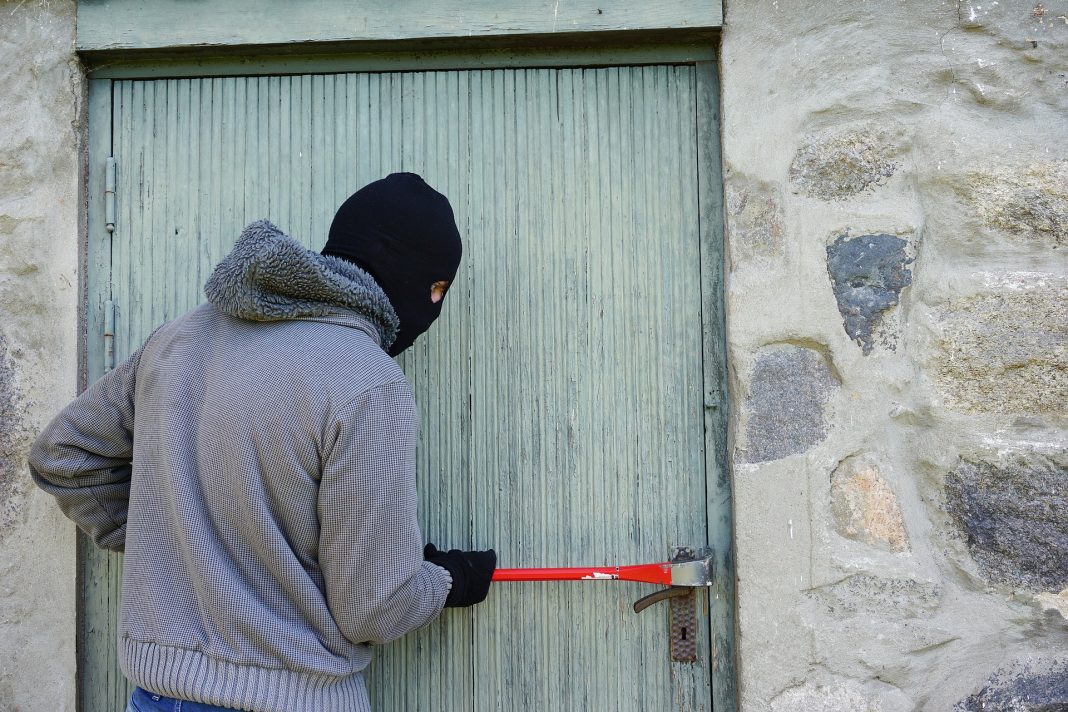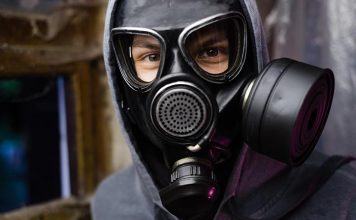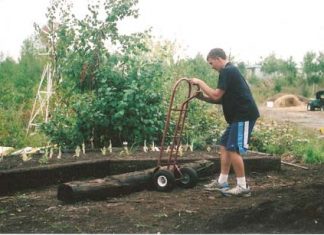 |
|
| Issue #89 • September/October, 2004 |
Read this month’s editorial. Publisher Dave Duffy got burgled. The residue of hurt this experience leaves behind is a primal thing that you never get over entirely. It strikes to the heart of our mammalian instincts when we experience a violation of the nest.
Dave got his wake-up call. The next intruder into his home, particularly while his wife and kids are there, is going to be flirting with a couple of .45 caliber gunshot wounds to the chest. If that happens, it won’t tear my heart out. (The burglar’s, maybe. Not mine.)
Your smart, professional burglars case their jobs carefully and hit empty homes. The ones who hit when you are there have to be considered dangerous. Either they know you and your loved ones are at home and are prepared to deal with you forcibly, or they are so incredibly stupid or spaced out that they are dangerous to themselves and others.
You cannot, of course, use deadly force merely because the intruder is in your house. But, if he attacks you after forcing his way into your home, he is bought and paid for. The best thing, of course, is to keep him from getting in at all.
|
So, what do you do about burglary prevention? The conventional wisdom is pretty much true, except for that BS about a gun in your home being 43 times more likely to kill you than to stop an intruder. That is probably the most thoroughly debunked false statistic to emerge from the burgeoning world of “junk science” in recent years.
I can’t come right out and tell you to get a gun. I don’t know you. There are certain people who are not emotionally suited, or just not ready, to possess the power of lethal force. But if you are emotionally stable, have good judgment, and are prepared to commit some time to learning how to shoot and when deadly force is justifiable, I would urge you to strongly consider the armed defense option.
Suggested reading
I can’t tell you enough about home security in a 3000-word article, and anyone who says he can is short-changing you. However, I can pass on some resources.
|
Drop by your local police department or sheriff’s office. You’ll leave with a substantial quantity of crime prevention brochures and leaflets. Request an officer, deputy, or trooper to be sent to your house to do a security analysis. Most law enforcement agencies will do this at no charge, though you may have to wait a while due to more pressing demands of emergencies and more urgent calls for police service.
Once you’ve digested that material and advice, Backwoods Home Magazine itself has some resources for you. A series of articles I did some time ago on the legal elements of deadly force in self-defense are available in various anthologies and/or online. So are some of my books. The Truth About Self-Protection runs some 232,000 words, according to Bantam Books, which published it. It covers the broad spectrum of crime prevention elements far better than anything I can do in a magazine article, and Dave and the Backwoods Home crew will give you a good deal on it.
If you have already decided to keep firearms for home protection, I would strongly recommend my book,In the Gravest Extreme: the Role of the Firearm in Personal Protection. It was written to give a lucid guide to when lethal force can be used in defense of self and family, and has stood the test of time and the courts. It, too, is available from Backwoods Home. StressFire (focusing on the handgun) and StressFire II (devoted to the defensive shotgun) cover the “how” of shooting effectively while under extreme pressure, while Gravest Extreme is devoted to the “when” element.
Covering the bases
The locksmith will tell you it’s all about locks. The alarm salesman will tell you it’s all about alarms. The guy at the puppy mill may tell you that all you need is a watchdog, and the clerk at the gunshop may tell you that the gun is the be-all and end-all.
Don’t fall for it. I hate to sound like a yuppie here, but you need a holistic approach. You need it all.
|
Dogs are great. They sense things you can’t sense, they smell things you can’t smell, and they intimidate people you may not be able to intimidate. A burglar climbing in a window was taken at gunpoint by a woman. He snarled at her, “You ain’t got the balls to shoot me.”
Wrong sentiment. She blew him away. But, you know, if she’d had a slavering Rottweiler at her side, I really don’t think that dude would have looked at the dog and said, “You ain’t got the balls to bite me.”
But dogs aren’t as smart as you. This is probably why dogs do not rule the Earth. Dave Duffy is likely going to be having a long talk with his Lab about why there was no barking and biting while people were in his house taking and damaging his stuff and, far worse, posing a threat to the people he most loves.
The dog can’t do it by itself
Good locks are a given. Yes, I know, you live in the boonies or in a small town because you wistfully long for those days when people could trust one another and leave their doors and windows unlocked. I hate to have to say it, but urban or rural, those days are over.
You want good locks. Think top brands like Medeco. But don’t make the mistake I’ve seen so many times in rural New England, where people paid big bucks to the locksmith to install high-tech locks in hollow core doors that a teenage junkie could kick through without breaking a sweat. Or they’ll have a thousand dollar hardwood door wrapped around that expensive lock, but the whole thing is sitting in the half-rotted and ill-fitting frame of a hundred year old house that has “settled.” The parts don’t fit, and that same anorexic teenage junkie can kick the whole door down like a drawbridge, lock and all.
The locks can’t do it by themselves
Alarms are important. That was probably the biggest thing missing from Dave’s home protection plan. I don’t think it will still be missing by the time you read this. Hey, I’m a gun guy. There’s always a loaded firearm within reach of where I’m sleeping. But if the knife at my throat is what woke me up, because there was no alarm to alert me in time, the gun ain’t gonna do me a helluva lot of good.
The guns won’t do it by themselves
Yet the alarm too is only a piece of the puzzle. Sometimes, an audible alarm frightens off the burglar as soon as it triggers. If that happens, you won, and the alarm system paid for itself then and there.
|
But if you really live in the backwoods, your particular burglar(s) might just have figured out that there’s no one else to hear it. They may have already calculated the odds and determined that you’re so far out in no-man’s-land that even if your alarm has connected immediately with the sheriff’s department or a security company’s dispatcher, they have ample time to loot your place before the cops can cover the long rural distance to get there.
Got a dictionary? Look up the definition of the word “alarm.” The last time I did that, the first definition I found was, “A call to arms.” If there’s nothing to back it up, what good is the alarm? It gives you a brief extra period in which to contemplate your doom.
So, the alarms won’t do it by themselves, either.
This is why you need a whole system. Good alarms. Good locks in good, solid, properly-fitting doors and windows. Defensive architecture: no bushes around the windows or other portals that shield a burglar from view as he works to break in. Good dogs, not just furry little four-footed burglar alarms, but critters trained to work in concert with you for home protection. And yes, if you’re ready for it, guns.
Don’t get ripped off on rip-off prevention
Yes, Virginia, there are fly-by-night alarm salesmen, as well as itinerant flim-flam “contractors” who’ll promise to “burglar-proof” your home. The locksmithing trade and firearms trade are pretty well self-regulated. A protection dog? There are more backyard breeders and phony dog trainers than there are phony black belt martial arts instructors and under-qualified firearms trainers combined.
|
What’s someone new to the territory to do? Once again, I recommend that you go to the cops.
Whoever is in charge of the crime prevention program at your local police department, county sheriff, or state patrol post can steer you toward bonded locksmiths with good reputations. They can also give you a list of approved/recommended alarm companies in the area. What they may not be able to do is come right out and recommend the best.
You have to ask the trick question: “Who would you get to alarm your house?” You see, the cops know who the shoddy installers with crappy equipment happen to be. These cops are the ones who have to report to the scene when those alarms go off every time there’s a thunderstorm. But, since it is not usually policy to recommend a particular brand while wearing a police uniform, it’s often impolitic to just come right out and ask. “Who do you use personally” is a better question.
To find reliable breeders and dog trainers will require a still more circuitous route. Few police K-9 handlers have a choice of breeder: absent grant funding or a very generous budget, most local police departments use donated dogs. Moreover, many of the trainers who work with police dogs do so exclusively and do not make their services available to private citizens.
So, what you do is this: Call your local law enforcement agency. Ask to speak to someone in the K-9 Unit. When you get that person, ask if he or she can recommend a veterinarian for a good-sized, working breed dog. If at all possible, you want to find out what vet takes care of the police department’s animals.
|
Now, go to that veterinarian. He or she will be familiar with the quality coming out of a given breeding or training establishment. The vet knows which animals he would trust with his own grandchildren. He’s also the guy who has to put down badly-bred dogs due to early hip dysplasia or other effects of backyard breeding, and the one who has to give the final needle to animals made vicious by cruel and ignorant “trainers” who tormented them into becoming junkyard dogs. This is a vet who can steer you in the right direction as to sources for the animals themselves, and for proper training.
Frankly, you don’t need to import a $10,000 Shepherd from Germany. If Rin-Tin-Tin or Lassie aren’t in the budget, Ol’ Yeller will do just fine. Head on down to the SPCA, and explain to the good folks there what you’re looking for. These are people who love animals, hate to put them down, and want to adopt out as many as they can. They know that word of mouth is what gets the most animals adopted, so they aren’t going to BS you like the paid-by-commission sales person at the Dog Factory at the mall. A big, strong, smart mongrel that likes human beings and is trainable will make a superb home protection animal.
Your police department can also be a resource for firearms training. Many years ago, the Orlando, Florida, Police Department made national news when, after a spate of rapes, they offered a firearms training program for women in the community. The publicity was just as intense locally. The criminals read the newspapers and watch TV, too. The result was a precipitous drop in the frequency of the crime of rape in that community. It’s Biology 101, really. Predators don’t seek the kind of prey that has its own fangs.
My own department has run deadly force training for citizens of the community who choose to keep or carry firearms for self-defense. We think it’s good for the department, safer for those individuals who already have guns, and a contribution to the public safety at large.
The state of Ohio recently passed legislation allowing concealed carry pistol permits for the first time there. The issuing authority will be the county sheriff’s department. Many of the sheriffs are putting together their own in-house training program to fulfill the new law’s mandatory training requirement. I for one think that’s a great idea, and I hope it catches on nationwide. But even if your department doesn’t offer training in weaponry to anyone but its own personnel, their firearms training staff will usually be happy to steer you to private instructors in the area who are competent and have a realistic, not Rambo-esque, attitude.
Common sense
Yes, I know that many of you moved to the country with a wistful longing to be someplace where you didn’t have to lock your doors. Unfortunately, that place may no longer exist. Criminals come to the backwoods, too. The sort of creature that columnist Mike Barnicle defined as YUMmies (Young Urban Maggots) have discovered that the Thin Blue Line of law enforcement is the thinnest in the sparsely populated hinterlands. A surprisingly large proportion of rural burglary is committed by urban criminals who travel to do their work.
|
Neighbors watch out for neighbors. It’s part of that good small town living ethos that you’ve been reading more about lately in Backwoods Home. Even if you can’t see your nearest neighbors’ homes from yours, it wouldn’t hurt for you and they to have an agreement to keep an eye out for unfamiliar vehicles or persons on one another’s property.
If you’re not so remote that you don’t have cell service, keep a cell phone handy. Not to be a Yuppie, but just for emergencies. Rural people are more likely to be out and about on their property as opposed to being within reach of a hard line phone than are city folk. You want to have instant emergency communication available, particularly when distances are long and police response time is necessarily long, too. If you’re way out there, consider ham radio.
Invest in a safe. You want it fire-resistant as well as burglar-resistant. If you’re building your dream house, build a corner of it around the safe and sink that baby into concrete. If you can’t do that, bolt it solidly to the floor. I know folks who have built false walls behind which lie hidden small rooms that hold their valuables more securely.
Let me share a quote with you from the book, Police for the Future, by David Bayley: “Police are, indeed, only a bandaid on cancer…We cannot rely upon the police, even when they are dedicated to preventing crime, to save society from crime.”
That fact is true. We are a free country with a minimal number of police. The hints above will let you make much better use of your community’s law enforcement than most citizens realize is possible. Hardened perimeters, homes which are difficult to enter and which have conspicuous Alarm System signs on them, and the barking of substantial size dogs, all are proven deterrents. But there are no guarantees. In the end, each of us is the best guarantor of our own safety.
Remember how when the kids came along, you had fire drills with them at home just like at school? Do an intrusion drill now and then. It’s just as important for the kids to know what the plan is going to be if home intruders actually do breach the security of the nest.
Good luck. Take care. Be safe.





















